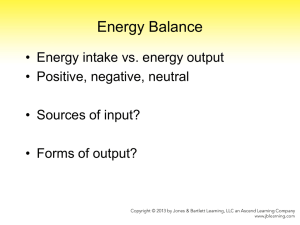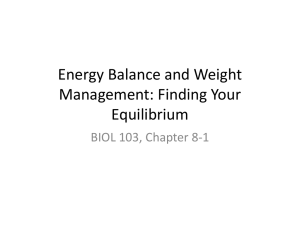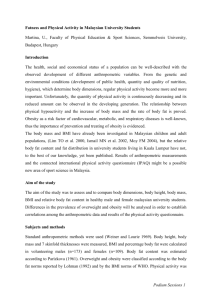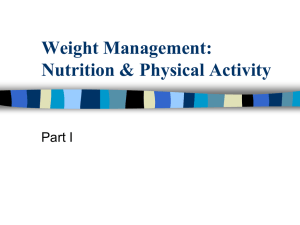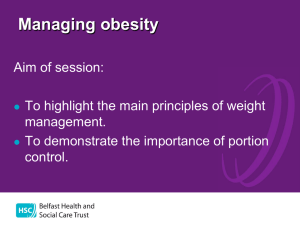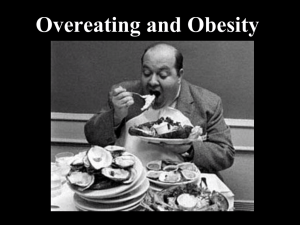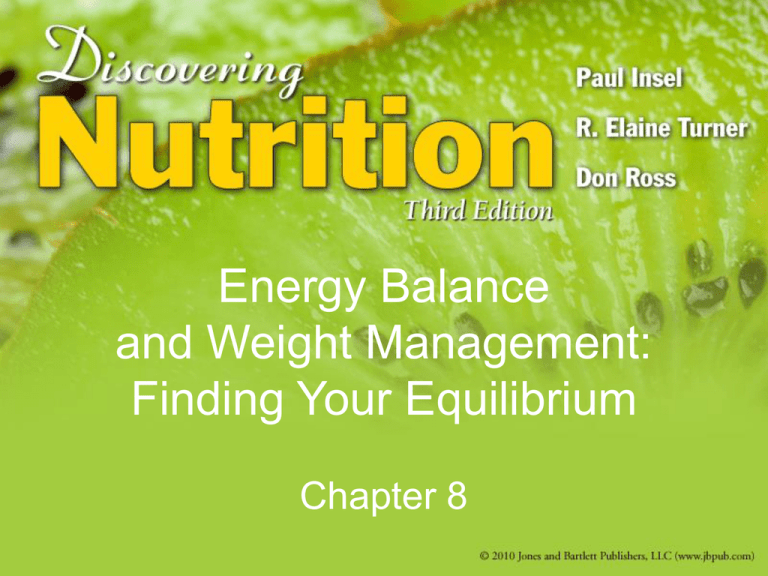
Energy Balance
and Weight Management:
Finding Your Equilibrium
Chapter 8
Energy Balance
• Energy intake vs. energy output
Energy Balance
• Energy equilibrium
– Intake = output
– Maintain weight
• Positive energy balance
– Intake > output
– Gain weight
• Negative energy balance
– Intake < output
– Lose weight
Energy In
• Regulation of intake
– Internal cues
• Hunger
–Prompts
eating
• Satiation
–Signals to
stop eating
• Satiety
–Tells when
you are ready
to eat again
Energy In
• Regulation of intake
– External cues
• Appetite
–Psychological desire to eat
–Influenced by the eating environment
Energy In
• Control by committee
– What stimulates our cues?
• Internal, physiological response
• Eating environment
Energy In
• Internal factors
– Gastrointestinal sensations
• Sense of fullness
– Neurological and hormonal factors
• Neuropeptide Y
• Ghrelin
• Leptin
Energy In
• External factors
– Diet composition
• Energy density, balance of energy
sources, and form
• Macronutrients
– Sensory properties
• Taste
© PhotoDisc
Energy In
• External factors
– Portion size
• Super-size culture
– Environment and social factors
• Hypothalamus
– Emotional factors
• Hypothalamus
Energy In: Regulatory Factors
Energy Out: Fuel Uses
• Total energy
expenditure
• Major components of
energy expenditure
– Energy expenditure at
rest (basal energy
expenditure)
• Energy for basic body
functions
• Affected by body
size, composition,
age, and gender
Energy Out: Fuel Uses
• Major components of
energy expenditure
– Physical activity
• Highly variable
• Affected by body
size, fitness level,
type of activity
– Thermic effect of food
(TEF)
• Energy to digest,
absorb, metabolize
food
Energy Out: Fuel Uses
• Estimating energy expenditure
– Resting energy expenditure (REE)
• 1.0 kcal/kg/hr for males
• 0.9 kcal/kg/hr for females
– Physical activity
• Add a % of REE (see Table 8.2)
– Thermic effect of food
• 6% to 10% of (REE + physical activity)
Estimating Energy Expenditure
• Estimated Energy Requirement (EER)
– Equations for males and females
• Factors for age, weight, height, and
physical activity
– Predicts total energy expenditure (TEE)
Body Composition: Understanding
Fatness and Weight
• Body composition
– Fat and lean muscle mass
• Assessing body weight
– Body mass index (BMI)
• Weight (kg) height2 (m)
• BMI 18.5 kg/m2 = underweight
• BMI 18.5 to 25 kg/m2 = normal weight
• BMI 25 to 30kg/m2 = overweight
• BMI 30 kg/m2 = obese
Body Composition: Understanding
Fatness and Weight
• Assessing body
fatness
– Underwater
weighing
– BodPod
– Skinfold
measurements
– Bioelectrical
impedance
Photo © Jones and Bartlett Publishers
Body Composition: Understanding
Fatness and Weight
• Body fat distribution
– Gynoid obesity (“pear”)
• Excess fat in hips and
thighs
– Android obesity (“apple”)
• Excess fat around abdomen
– Waist circumference
Overweight and Obesity
• Major public health problem
– American Youth
– Healthy People 2010
© Bobby Deal/Dreamstime.com
Overweight and Obesity
• Factors in development of obesity
– Biological
• Heredity
• Gene-environment
• Fat cell development
• Sex and age
• Race and ethnicity
Overweight and Obesity
• Factors in development of obesity
– Social and environmental
• Socioeconomic status
• Built environment
–“Human formed, developed, or
structured areas”
• Social factors
Overweight and Obesity
• Factors in development of obesity
– Lifestyle and behavioral
• Physical activity
–Lack of exercise
• Psychological factors
–Restrained eaters
–Binge eaters
Overweight and Obesity
• Health risks of overweight and obesity
– Heart disease, stroke, diabetes,
hypertension, metabolic syndrome, cancer,
gallbladder disease, joint disease, and
sleep apnea
• Weight cycling
– Low LDL cholesterol, hypertension
Weight Management
• Weight management is the adoption of
healthful and sustainable eating and
exercise behaviors indicated for
reduced disease risk and improved
feelings of energy and well-being.
Weight Management
• Perception of weight
• Setting realistic goals
– Metabolic fitness
Weight Management
• Weight-management lifestyle
• Diet and eating habits
– Total calories
– Crash diets don’t work
– Balancing energy
sources: fat
– Balancing energy
sources: protein
– Eating habits
– Physical activity
Weight Management
• Thinking and emotions
– Stress management
– Balancing acceptance and change
Weight Management
• Weight-management approaches
– Self-help books and manuals
• Watch for signs of a fad diet
– Meal replacements
– Self-help groups
– Commercial programs
– Professional counselors
– Antiobesity prescription drugs
Weight Management
• Weight-management approaches
– Prescription drugs
– Over-the-counter drugs and dietary
supplements
• Cautions of safety/ingredients
Weight Management
• Weight-management
approaches
– Surgery
• Extreme obesity
• Last ditch effort
• Gastric banding
• Gastric bypass
Underweight
• Causes and assessment
– Altered responses
– Eating disorders factors
– Metabolic and heredity factors
– Prolonged physical and emotional stress
– Addiction to alcohol and street drugs
– Bizarre diet patterns
Underweight
• Weight-gain strategies
– Small, frequent meals
– Fluids between meals
– High-calorie foods and beverages
– Timers or other cues
– Vitamin/mineral supplements

